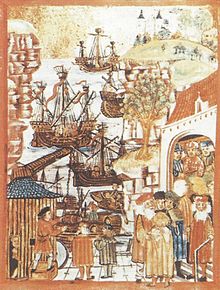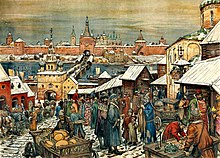Peterhof (Novgorod)
The Peterhof (Lat. Curia Sancti Petri ) in Novgorod was one of four counting houses of the Hanseatic League in the late Middle Ages.
location
The Peterhof was in Novgorod, on the right bank of the Volkhov, the trading side of the city, and bordered the Novgorod market.
history
The easternmost office of the Hanseatic League in Novgorod existed from the middle of the 13th century , initially under the dominant influence of the Gotland Riders ' cooperative . It is of particular historical importance because the internal rules, i.e. the court order of this trading base, Schra or, because of the seven surviving versions, also called Schraen in the majority , have been handed down so that the organizational processes can still be traced today.
The office was in a palisade-fenced district of Novgorod, which had only one entrance gate. For fear of robberies and theft, the Russians were only allowed to enter the Peterhof during the day to do purchases and sales. Business with the Germans outside the office was forbidden. At night the gate was tightly locked. The focal point was the stone, eponymous church of St. Peter , which served as a meeting place for the merchants, a permanent place of storage for documents and the cash desk of the office, a place of scales and a warehouse. Around the church were the wooden houses in which the approx. 200 merchants on one side and the journeymen and apprentices on the other lived in communities. In addition, there were the commercial and administrative buildings, a brewery kitchen and storage shed. In the event of danger, the stone church building served as a place of refuge.
Novgorod was the only Hansekontor that was not in a seaport and was approached by water from the Gulf of Finland via the Neva , Lake Ladoga and the Volkhov coming from Lake Ilmen . To do this, the goods had to be reloaded onto shallow river boats. Because the journey there was difficult and exhausting, the merchants stayed either all summer (summer drivers) or all winter (winter drivers). However, there were no merchants or assistants permanently present as in the other three offices, the London Stalhof , Bryggen in Bergen or Bruges . During the absence, the office's cash register was kept in the Marienkirche in Visby on Gotland in accordance with the provisions of the Schra .
The office was under the management of an old man , whose powers, due to the remote location, were probably much more extensive than in the other offices. The sovereignty was initially due to Visby as Oberhof, then with the rapid rise of Lübeck from 1293 onwards to this as Oberhof . After a trade boycott against Russia by the Hanseatic League, Lübeck's mayor Johann Niebur put the situation on a new basis in 1392 with the agreement known as Niebur's kiss of the cross . With the flourishing of the Livonian Hanseatic cities in the 15th century, Lübeck was also forced out of its supremacy from 1442 onwards. These power struggles showed the economic importance of this eastern end point of the Hanseatic trading system, where goods from Flanders and London (such as cloth) were traded for primary products from Russia. In 1494 the office was opened by Tsar Ivan III. closed and destroyed. The trade of the Hanseatic League, especially Lübeck, shifted to Pleskau and Narva after a while . After the destruction by Tsar Ivan, there are no more buildings from the Hanseatic era in Novgorod.
Varia

- The medieval picture panels of the Russia driver stalls in the Nikolaikirche in Stralsund are among the rare representations of the Russian trade during the Hanseatic era.
- The conversation and dictionary of the Lübeck merchant's assistant Tönnies Fonne , which was created in Pleskau in 1607, provides information about the trade between German and Russian merchants .
- The coat of arms of the Lübeck merchant company of Novgorod drivers , which was established in the late Middle Ages, can be seen next to those of the other companies in the Schiffergesellschaft . The Nowgorodfahrer went in 1853 like all other Lubeck Kaufmannskompagnien the merchants of Luebeck , which now runs as a public corporation and successor all Arms / Seal in their risen corporations still in its (Alliance) seal.
- St. Prokop of Ustyug worked as a Hanseatic merchant in the office before he became Jurodiwy .
literature
- Norbert Angermann , Klaus Friedland (eds.): Novgorod. Hanse market and office. Böhlau Verlag 2002, ISBN 3-412-13701-4 .
- Jelena A. Rybina: Inozemnye dvory v Novgorode [The foreign courts in Novgorod], Moskva 1986.
- Jelena A. Rybina: Torgovlja srednevekovogo Novgoroda. Istoriko-archeologičeskie očerki [Trade from medieval Novgorod. Historical and archaeological contributions], Velikij Novgorod 2001.
- Philippe Dollinger : The Hanseatic League . ISBN 3-520-37102-2
- Antjekathrin Graßmann : Lübeckische Geschichte . ISBN 3-7950-3203-2
Web links
- Ernst Schubert: Novgorod, Bruges, Bergen and London: Die Kontore der Hanse (2002) (with references to older literature)
Individual evidence
- ^ A b Philippe Dollinger: The Hanseatic League (pages 126, 238)
- ↑ see → 3 in the map of the historical Novgorod
Coordinates: 58 ° 31 ′ 5 ″ N , 31 ° 17 ′ 14 ″ E

